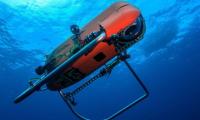Operation Dwarka 1965: A golden chapter in naval history
History is all about interpretation. It is always there to provide whatever is required to the reader or learner at that moment. It gives motivation, it boosts self-esteem and it establishes a sense of pride. It defines historical phenomenon, providing a list of regrets and lessons that all parties can learn from. The basis for a state's policies is provided by negative and positive aspects of history. There are many events and decisions which can become a permanent source of motivation and pride or even ignominy in the history of any nation. Yet, the most difficult events of history to be analysed are all related with the military: the wars and violent conflicts. One can see difference of opinions and perspectives quite vividly, especially when wars between Pakistan and India are mentioned and studied academically.
Since Pakistan's inception in 1947, there was visible discrepancy regarding the distribution of assets between Pakistan and India. Similar was the case with military share, the discrepancy being quite discernible with the navy specifically. The Pakistan Navy got a small share in the form of 2 sloops, 4 fleet minesweepers, 4 harbour defence launches, 2 trawlers, 2 frigates (keep in mind that technologically those frigates were nowhere near the modern frigates), and around 3600 personnel including 180 officers. Under the Western arrangements of SEATO and CENTO to contain Communism in 1950s, Pakistan got limited military assistance, making the purchase and supply of naval equipment possible, but quite limited. Nevertheless, the addition of a submarine (ex-US TENCH class) to the Pakistan Naval Fleet in 1964 was a remarkable step that proved to be a major deterrent to any neighbouring country that was considering attack. This submarine was named “Ghazi”. It was only the second submarine in the entire Indian Ocean Region and soon became active for patrolling its waters.
As Pakistan and India have been locked into enmity since the beginning of their inception, with India being larger and comparatively stronger on the power matrix, security naturally became the primary concern for Pakistan. Despite such imbalance in power, Pakistan has performed quite exceptionally in all the challenges it has been faced with. The exemplary success of Operation Dwarka in the wake of the 1965 Pakistan-India War was one such incident which became a proud part of the history of Pakistan. In the heat of war, the Indian Navy was focusing mainly at West Pakistan, which compelled Pakistan to ensure the security of its maritime boundaries in the Arabian Sea and in the Sea Lines of Communication (SLOCs) for uninterrupted trade and commercial activities, along with the inland water defence in the creek areas and estuaries of West and East Pakistan against potential Indian amphibious assaults. Essentially, these were the tasks successfully undertaken by the Pakistan Navy, with comparatively inferior logistics and naval technology than India. In those challenging days, Operation Dwarka emerged as a symbol of perseverance and showed the professional capabilities of the Pakistan Navy, despite all the hurdles and naval power imbalances.
Dwarka is a coastal city of Gujrat, situated on the north-western peninsula, it has been quite significant for India - not only religiously and culturally, but militarily too. This was where the radar installation for guiding the Indian Air Force to launch attacks on important cities of Pakistan, especially Karachi, took place. The core objective of Operation Dwarka was multi-fold in effect, as it was not only aimed at the destruction of said radar but to provoke the Indian warships stationed at erstwhile Bombay (now Mumbai) Port to come to the Arabian Sea where Pakistani submarine “Ghazi” was prowling, waiting to engage those ships. That Operation was launched on 8th September, 1965, and it involved seven Pakistan Naval vessels, while the submarine was waiting in the open sea. The bombardment of identified targets was completed in merely four minutes.
Operation Dwarka was not simply a naval mission, it had many different aspects. It was the beginning of the formal naval warfare between Pakistan and India, with the roaring success of the Pakistan Navy as preamble to future naval developments. It acquired its objectives as the success of the operation left India licking its wounds; no retaliatory air, naval or amphibious assault was undertaken on the coastline by Indian forces after that. The operation also proved a as a litmus test for the operational preparedness, coordination, and precision of the Pakistan Navy as it was a most successful mission: the given plan was followed fully and all targets were achieved as instructed, despite the command of no radio communication being administered. Above all, Operation Dwarka lowered the morale of the Indian Navy significantly - to the point that even the Indian warship “INS-Mysore”, which was stationed close-by at Cochin, did not respond to the assault launched by the Pakistan Navy.
The shining success of this operation wrote an incredible chapter in the history of Pakistan and proved overture for further naval developments, not only for Pakistan, but on a regional level in Asia. Although, India denied the destruction of the radar and its beacon and of other massive losses of city installations, the operation still left an unforgettable imprint of humiliation for India. In 1971, “Ghazi” was struck by one of its own mines while mining the harbour near Vishakapatnam, resulting in it being sunk. India claimed that this was a result of their navy targeting the submarine, but in actuality, the Pakistan Navy's sub-surface operational expertise has remained un-shattered by the Indian Navy, providing immense pride and grace.
The Pakistan Navy commemorates 8th September as the day of its victory every year and honours the officers who participated in this operation for bringing such success to the country. The Pakistan Navy has gained respect due to the effective roles it plays at different levels, particularly in “Blue Diplomacy”. The Pakistan Navy has been connected with other actors through performing assigned roles in Task Forces 150, 151, and 152; providing training and operational assistance to other regional navies; and participating in the initiation of the Regional Maritime Security Patrol (RMSP) since 2018.
Pakistan believes in the freedom of seas, as well as security of SLOCs from traditional and non-traditional threats and challenges. As such, the navy has proved itself a credible “Guardian” of Pakistan's vast maritime frontier.
Without any doubt, the Pakistan Navy is fully capable of defending its homeland against any threat or challenges of the contemporary era, and its commitment to national and common security is highly appreciable.
-Maliha Zeba Khan is working as an Assistant Professor at the
Department of International Relations, NUML, Islamabad. She can be reached at:
malihazkhan@gmail.com
-
 Queens Mother Arrested After Abducting Child From Court-ordered Visit
Queens Mother Arrested After Abducting Child From Court-ordered Visit -
 Sarah Ferguson Ready To ‘spread Her Wings’ After Separating From ‘disgraced’ Andrew
Sarah Ferguson Ready To ‘spread Her Wings’ After Separating From ‘disgraced’ Andrew -
 Finn Wolfhard Shares How Industry Views Him Post 'Stranger Things'
Finn Wolfhard Shares How Industry Views Him Post 'Stranger Things' -
 Dylan O'Brien Gets Nostalgic After Reunion With Old Friend
Dylan O'Brien Gets Nostalgic After Reunion With Old Friend -
 UK Doctors Warn Screen Time Is Harming Children’s Health
UK Doctors Warn Screen Time Is Harming Children’s Health -
 Meghan Markle To Get Police Protection In UK If Travelling With Archie, Lilibet
Meghan Markle To Get Police Protection In UK If Travelling With Archie, Lilibet -
 Spencer Pratt Expresses Hope For Taylor Swift, Travis Kelce's Wedding Invite
Spencer Pratt Expresses Hope For Taylor Swift, Travis Kelce's Wedding Invite -
 Evan Peters Makes Unexpected Confession About 'American Horror Story' Season 13
Evan Peters Makes Unexpected Confession About 'American Horror Story' Season 13 -
 Kentucky Grandmother Arrested After Toddlers With Broken Skulls, Ribs
Kentucky Grandmother Arrested After Toddlers With Broken Skulls, Ribs -
 European Space Agency Hit By Cyberattack, Hundreds Of GBs Data Leaked
European Space Agency Hit By Cyberattack, Hundreds Of GBs Data Leaked -
 Elon Musk’s XAI Launches World’s First Gigawatt AI Supercluster To Rival OpenAI And Anthropic
Elon Musk’s XAI Launches World’s First Gigawatt AI Supercluster To Rival OpenAI And Anthropic -
 Google Adds On-device AI Scam Detection To Chrome
Google Adds On-device AI Scam Detection To Chrome -
 First Ocean Robot Launched To Monitor 'Category 5' Hurricanes
First Ocean Robot Launched To Monitor 'Category 5' Hurricanes -
 Gwyneth Paltrow Gets Honest About Filming Intimate Scenes With Timothee Chalamet
Gwyneth Paltrow Gets Honest About Filming Intimate Scenes With Timothee Chalamet -
 Duke's Peace Talks With King Charles, Prince William: 'Ball Is In Harry's Court'
Duke's Peace Talks With King Charles, Prince William: 'Ball Is In Harry's Court' -
 New Research Finds Back Pain May Disrupt Men’s Sleep Quality Later In Life
New Research Finds Back Pain May Disrupt Men’s Sleep Quality Later In Life



